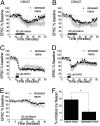Distinct forms of Gq-receptor-dependent plasticity of excitatory transmission in the BNST are differentially affected by stress
- PMID: 20133871
- PMCID: PMC2836642
- DOI: 10.1073/pnas.0905568107
Distinct forms of Gq-receptor-dependent plasticity of excitatory transmission in the BNST are differentially affected by stress
Abstract
Long-term depression (LTD) is an important synaptic mechanism for limiting excitatory influence over circuits subserving cognitive and emotional behavior. A major means of LTD induction is through the recruitment of signaling via G(q)-linked receptors activated by norepinephrine (NE), acetylcholine, and glutamate. Receptors from these transmitter families have been proposed to converge on a common postsynaptic LTD maintenance mechanism, such that hetero- and homosynaptic induction produce similar alterations in glutamate synapse efficacy. We report that in the dorsolateral and ventrolateral bed nucleus of the stria terminalis (BNST), recruitment of G(q)-linked receptors by glutamate or NE initiates mechanistically distinct forms of postsynaptically maintained LTD and these LTDs are differentially regulated by stress exposure. In particular, we show that although both mGluR5- and alpha(1)-adrenergic receptor (AR)-dependent LTDs involve postsynaptic endocytosis, the alpha(1)-AR-initiated LTD exclusively involves modulation of signaling through calcium-permeable AMPA receptors. Further, alpha(1)-AR- but not mGluR5- dependent LTD is disrupted by restraint stress. alpha(1)-AR LTD is also impaired in mice chronically exposed to ethanol. These data thus suggest that in the BNST, NE- and glutamate-activated G(q)-linked signaling pathways differentially tune glutamate synapse efficacy in response to stress.
Conflict of interest statement
The authors declare no conflict of interest.
Figures





Similar articles
-
In vivo metabotropic glutamate receptor 5 (mGluR5) antagonism prevents cocaine-induced disruption of postsynaptically maintained mGluR5-dependent long-term depression.J Neurosci. 2008 Sep 10;28(37):9261-70. doi: 10.1523/JNEUROSCI.2886-08.2008. J Neurosci. 2008. PMID: 18784306 Free PMC article.
-
Alpha1-adrenergic receptor-induced heterosynaptic long-term depression in the bed nucleus of the stria terminalis is disrupted in mouse models of affective disorders.Neuropsychopharmacology. 2008 Sep;33(10):2313-23. doi: 10.1038/sj.npp.1301635. Epub 2007 Nov 28. Neuropsychopharmacology. 2008. PMID: 18046308 Free PMC article.
-
Extracellular-signal regulated kinase 1-dependent metabotropic glutamate receptor 5-induced long-term depression in the bed nucleus of the stria terminalis is disrupted by cocaine administration.J Neurosci. 2006 Mar 22;26(12):3210-9. doi: 10.1523/JNEUROSCI.0170-06.2006. J Neurosci. 2006. PMID: 16554472 Free PMC article.
-
Modulation of glutamatergic synaptic transmission in the bed nucleus of the stria terminalis.Prog Neuropsychopharmacol Biol Psychiatry. 2009 Nov 13;33(8):1329-35. doi: 10.1016/j.pnpbp.2009.05.022. Epub 2009 Jun 11. Prog Neuropsychopharmacol Biol Psychiatry. 2009. PMID: 19524008 Free PMC article. Review.
-
Molecular mechanisms coordinating functional and morphological plasticity at the synapse: role of GluA2/N-cadherin interaction-mediated actin signaling in mGluR-dependent LTD.Cell Signal. 2013 Feb;25(2):397-402. doi: 10.1016/j.cellsig.2012.11.007. Epub 2012 Nov 12. Cell Signal. 2013. PMID: 23153583 Review.
Cited by
-
Intrinsic connections in the anterior part of the bed nucleus of the stria terminalis.J Neurophysiol. 2013 May;109(10):2438-50. doi: 10.1152/jn.00004.2013. Epub 2013 Feb 27. J Neurophysiol. 2013. PMID: 23446692 Free PMC article.
-
Extended amygdala circuits are differentially activated by context fear conditioning in male and female rats.Neurobiol Learn Mem. 2021 Apr;180:107401. doi: 10.1016/j.nlm.2021.107401. Epub 2021 Feb 11. Neurobiol Learn Mem. 2021. PMID: 33581315 Free PMC article.
-
Chronic stress-induced synaptic changes to corticotropin-releasing factor-signaling in the bed nucleus of the stria terminalis.Front Behav Neurosci. 2022 Aug 2;16:903782. doi: 10.3389/fnbeh.2022.903782. eCollection 2022. Front Behav Neurosci. 2022. PMID: 35983475 Free PMC article. Review.
-
A Basal Forebrain Site Coordinates the Modulation of Endocrine and Behavioral Stress Responses via Divergent Neural Pathways.J Neurosci. 2016 Aug 17;36(33):8687-99. doi: 10.1523/JNEUROSCI.1185-16.2016. J Neurosci. 2016. PMID: 27535914 Free PMC article.
-
Extracellular alpha-synuclein oligomers modulate synaptic transmission and impair LTP via NMDA-receptor activation.J Neurosci. 2012 Aug 22;32(34):11750-62. doi: 10.1523/JNEUROSCI.0234-12.2012. J Neurosci. 2012. PMID: 22915117 Free PMC article.
References
-
- Drolet G, editor. Progress in Neuro-Psychopharmacology and Biological Psychiatry . Vol. 33. New York: Elsevier; 2009. - PubMed
-
- Forray MI, Gysling K. Role of noradrenergic projections to the bed nucleus of the stria terminalis in the regulation of the hypothalamic-pituitary-adrenal axis. Brain Res Brain Res Rev. 2004;47:145–160. - PubMed
-
- Bossert JM, Ghitza UE, Lu L, Epstein DH, Shaham Y. Neurobiology of relapse to heroin and cocaine seeking: An update and clinical implications. Eur J Pharmacol. 2005;526(1-3):36–50. - PubMed
Publication types
MeSH terms
Substances
Grants and funding
LinkOut - more resources
Full Text Sources
Other Literature Sources
Research Materials

